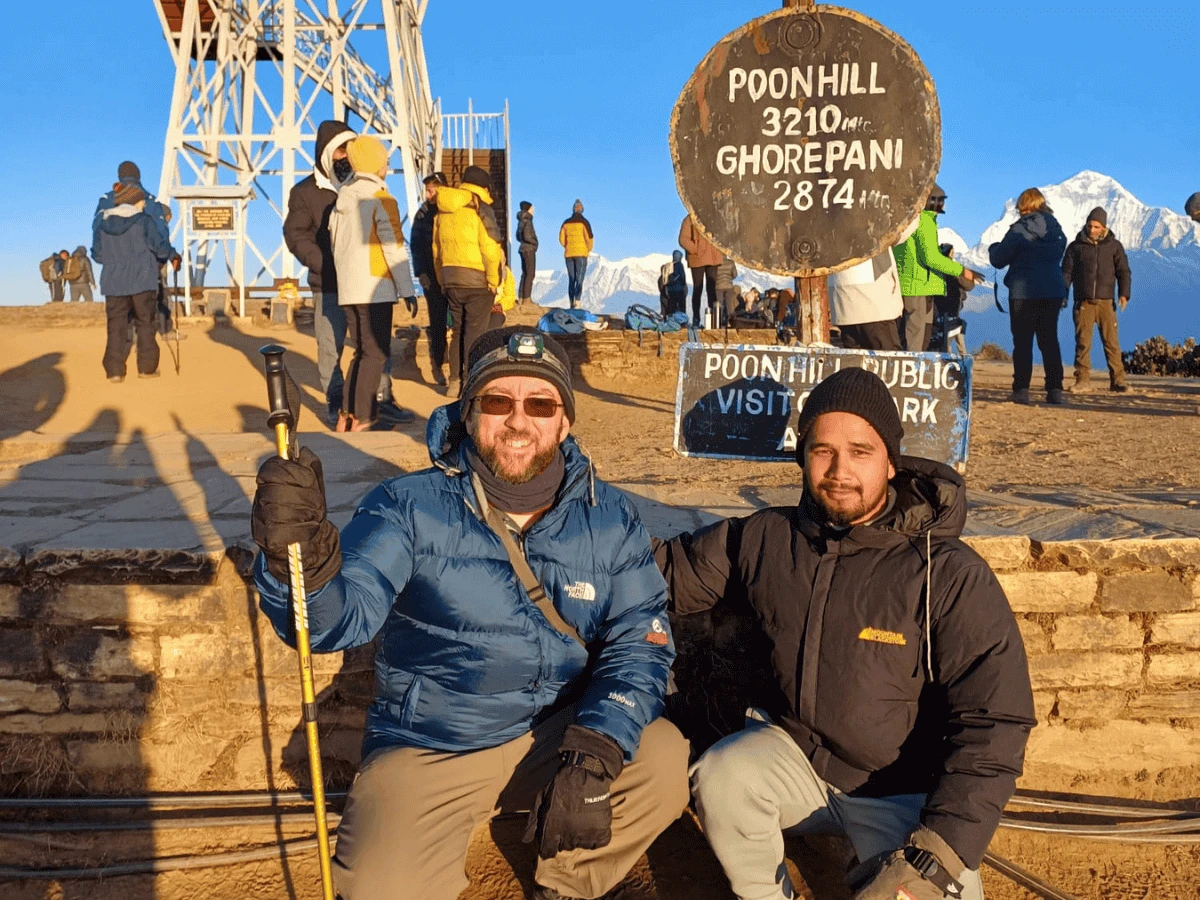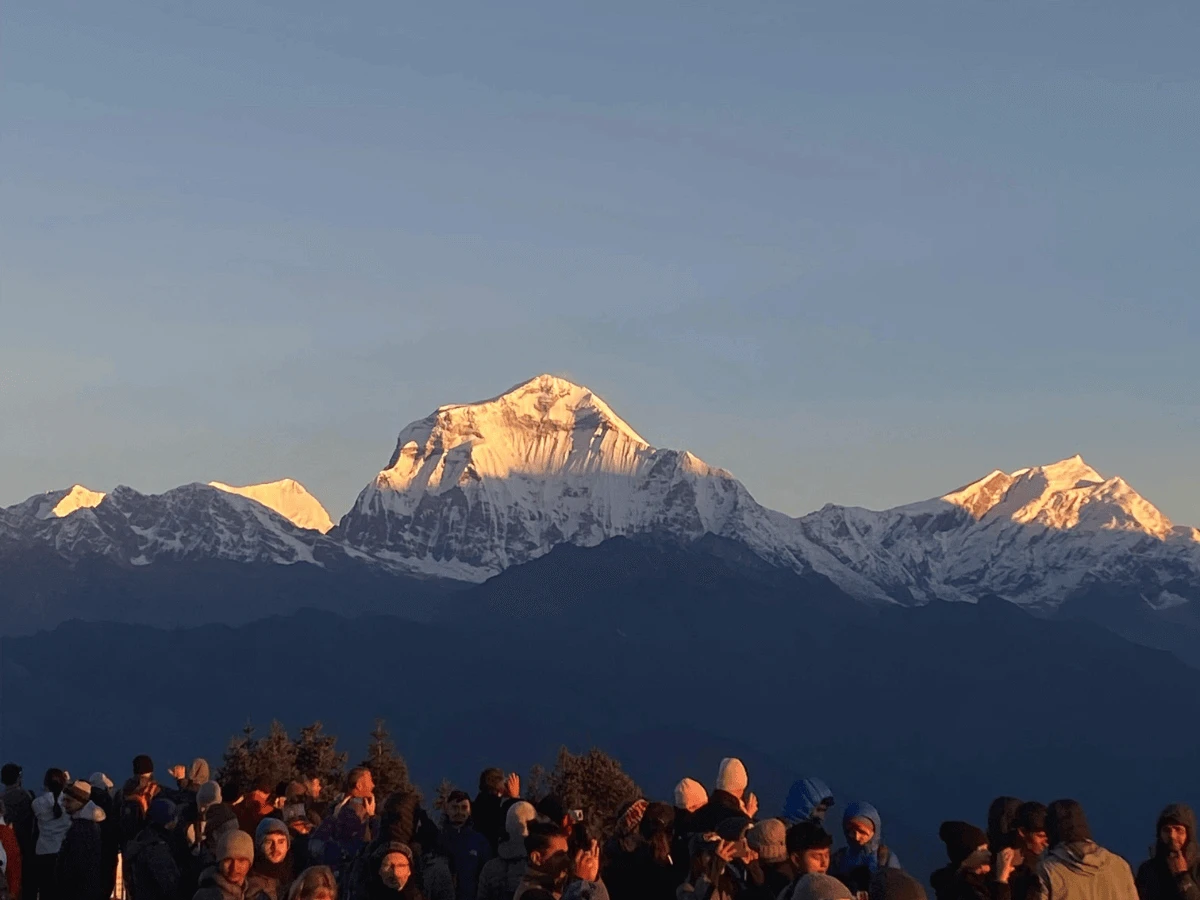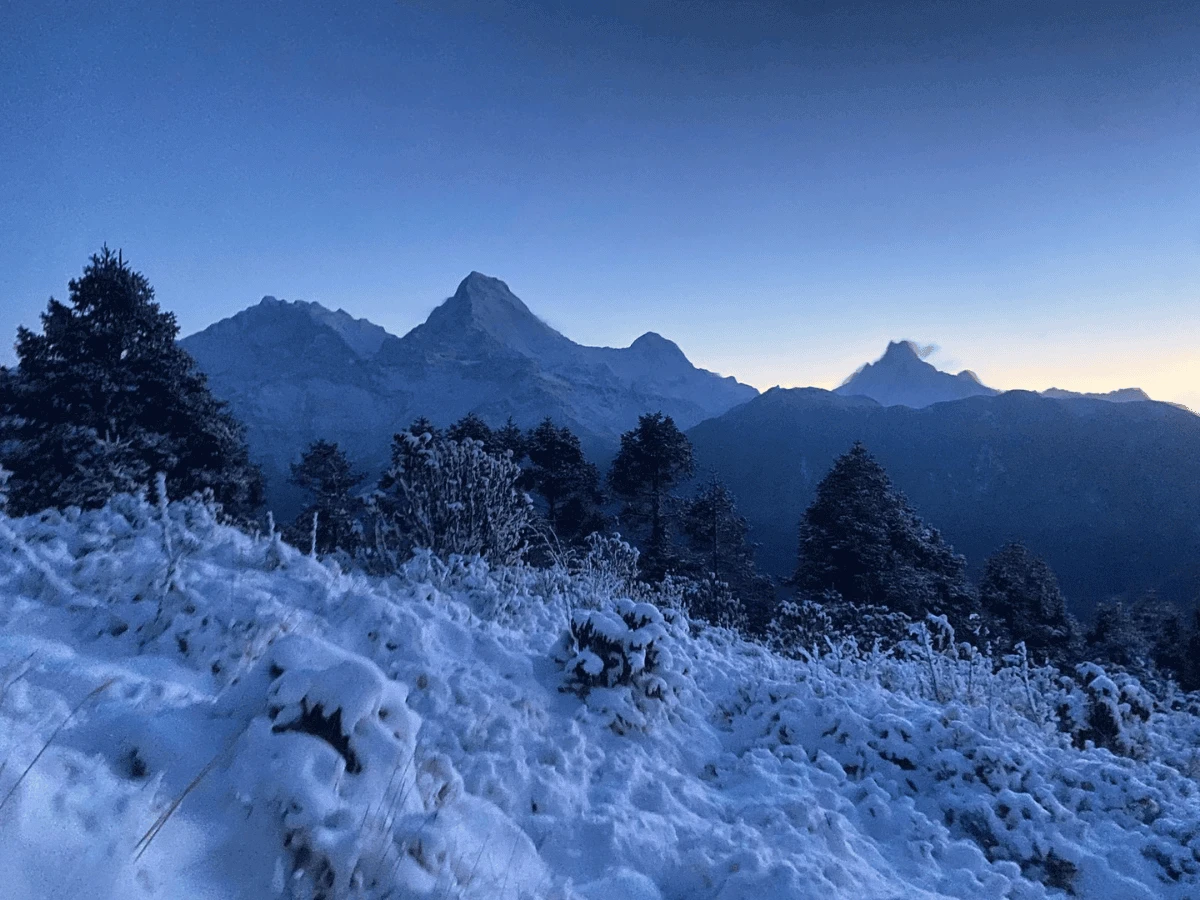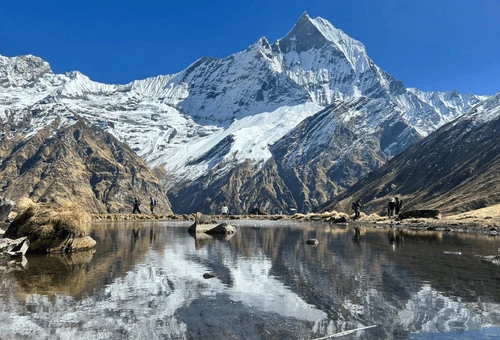Nestled in Nepal’s Annapurna region, the Ghorepani Poon Hill Trek is one of the country’s most popular short treks. This adventure combines natural beauty, cultural encounters, and a manageable challenge, making it perfect for trekkers from all around the world. It lies to the West of another popular trek in Nepal, the Annapurna Base Camp Trek, which can even be combined with the Poon Hill Trek for a more adventurous and thrilling journey.
Over just 5–6 days on the trail, you’ll traverse terraced hillsides, lush rhododendron forests, and charming mountain villages before reaching Poon Hill – a renowned sunrise viewpoint over the Himalayas. The highest point of the Poon Hill Hike is 3200 meters above the Ghorepani Village. Despite its relatively short length, the trek rewards you with panoramic views of the Annapurna and Dhaulagiri ranges and an immersive taste of Nepali hill culture.
If you’re looking for an adventurous yet accessible trekking experience in Nepal, the Ghorepani Poon Hill trek deserves a top spot on your bucket list. Whether you're a novice hiker, a photographer hunting the perfect sunrise, or a culture enthusiast looking to immerse yourself in Nepalese village life, this trail delivers everything you are looking for in the Himalayas.
Why Choose Ghorepani Poon Hill Trek Nepal?
The Ghorepani Poon Hill Trek in Nepal is more than just a hike. It's an opportunity to stand at 3,210 meters above sea level and watch the Himalayan giants glow in golden hues. Moreover, the trek is not just a walk through the lush green forest, but provides an opportunity to witness Himalayan wildlife along with the mountains. Here's why it's a must-do:
- Beginner-friendly and short-duration trek
- Panoramic views of Annapurna South, Machhapuchhre (Fishtail), Hiunchuli, and Dhaulagiri
- Rhododendron forests that blaze with colour in spring
- Authentic cultural experience in Ghorepani, Tadapani, and Ghandruk
- No high-altitude sickness risk
- Flexible itinerary: from 2-day quick hikes to 6-day immersive journeys
Highlights of the Poon Hill Trek in Nepal
The Ghorepani Poon Hill trek may be shorter than Nepal’s grand expeditions, but it certainly doesn’t lack for incredible sights and experiences. Here are some of the top highlights and unique features that make this trek so popular:
Spectacular Himalayan Sunrises: The pre-dawn climb to Poon Hill is rewarded by an unforgettable sunrise over the Himalayas. As the sun peaks above the horizon, it bathes Mount Dhaulagiri, Annapurna I, Annapurna South,Machhapuchhre (Fishtail), Hiunchuli, and a panorama of other peaks in golden light.
Lush Rhododendron Forests: Trekking through the Annapurna Conservation Area, you’ll traverse hills blanketed in dense rhododendron forests. If you hike in spring (March-April), these woodlands erupt in colour as Nepal’s national flower – the rhododendron – blooms in brilliant reds, pinks, and purples.
Tranquil Mountain Villages & Culture: The route connects traditional Gurung and Magar villages, allowing you to experience the rich culture of Nepal’s hill communities. You’ll stay in teahouse lodges run by local families in villages like Tikhedhunga, Ghorepani, Tadapani, and Ghandruk. Along the way, interact with friendly villagers, shepherds, and curious schoolchildren.
Continuous Mountain Views: Unlike some treks that save all the views for the end, the Poon Hill trek offers mountain scenery throughout. From Day 2 onward, you’ll catch stunning glimpses of peaks whenever the terrain opens up. The trail from Ghorepani to Tadapani goes over ridges that unveil both the Annapurna and Dhaulagiri ranges. And in Ghandruk, you wake up to massive Annapurna South (7,219 m) and Machhapuchhre (6,993 m).
Short, Flexible & Accessible: One of the great appeals of Poon Hill is that it’s a relatively short trek in Nepal. In under a week, you get a Himalayan summit view, cultural insight, and ecological diversity. The trek can be done in as few as 3-4 days or extended to a week, depending on your schedule. It’s also easily accessible, starting just an hour’s drive from Pokhara (which itself is a 6-7 hour tourist bus or a 25-minute flight from Kathmandu).
These are just a few of the many highlights awaiting you on the Ghorepani Poon Hill trek. Every trekker comes away with their favourite memories.
How Hard Is the Ghorepani Poon Hill Trek?
Many travellers often ask, “How hard is the Poon Hill trek?” The good news is that Ghorepani Poon Hill is considered an easy-to-moderate trek. Unlike high-altitude expeditions, like the Annapurna Circuit Trek, this trek stays at fairly lower elevations (max. 3,210 m at Poon Hill). Trekkers with a reasonable level of fitness – able to walk 5-6 hours a day can do this trek.
The most difficult part is typically the steep stone staircase from Tikhedhunga up to Ulleri. After Ulleri, the paths gradually ascend through forests with plenty of rest stops. Take it slow on the stairs, use trekking poles if you have them.
Overall, the Poon Hill trek difficulty is rated easy to moderate. You don’t need prior trekking experience. Daily walking distances range from 5 to 12 km with 4–7 hours on the trail. Altitude gain is fairly gradual, allowing your body to adjust. At 3,210 m, altitude sickness is rarely a major concern on this trek – it’s low enough that serious Acute Mountain Sickness is unlikely for most people.
6-Day Ghorepani Poon Hill Trek Itinerary Map & Distance
Where is the trek, and how far will you walk? The Ghorepani Poon Hill circuit is located in central Nepal, within the Annapurna Conservation Area. The trek begins at Nayapul (approx. 1,070 m), a small roadside town about 42 km from Pokhara.
From Nayapul, the route forms a loop through Gurung and Magar villages, ascending one way and returning via a different path. Trekkers usually ascend via Ulleri to Ghorepani, then hike to Poon Hill for the sunrise, and descend via Tadapani and Ghandruk. In total, the trekking distance of Ghorepani Poon Hill is about 50–55 km (30–34 miles).
It’s helpful to review a Ghorepani Poon Hill trek map before you go, to visualise the route and key checkpoints. Many trekking agencies provide a route map highlighting the trail from Nayapul – Tikhedhunga – Ghorepani – Poon Hill – Tadapani – Ghandruk – Nayapul.
How much does the Ghorepani Poon Hill trek cost?
The cost can vary depending on whether you go with a trekking agency package or independently, and your spending. If you book a Ghorepani Poon Hill trek package, expect roughly USD 500–$700 per person for a 5-6 day trip from Kathmandu/Pokhara, all-inclusive. Mountain Eco Trails offers the 6-day trek for around $580 per person (with group discounts), which includes permits, guide, transportation, accommodations, and meals. That is a good value considering it covers almost everything once you’re in Nepal.
Ready to Trek? Book with Mountain Eco Trails
Embarking on the Ghorepani Poon Hill trek is easier and more rewarding when you have the right team supporting you. Mountain Eco Trails is here to turn your trekking dreams into reality. With our expert local guides, eco-friendly approach, and attention to every detail, we ensure your Poon Hill experience is safe, seamless, and unforgettable. Contact us for more details or WhatsApp at +9779849790153.




.webp)

